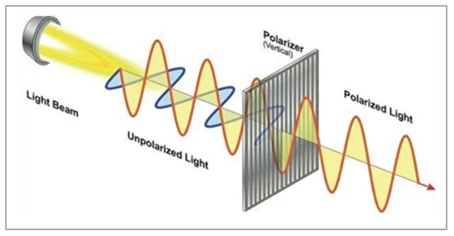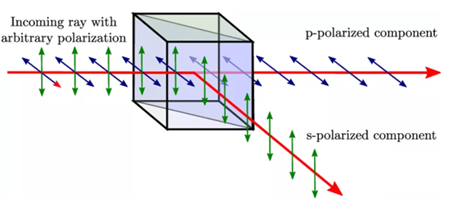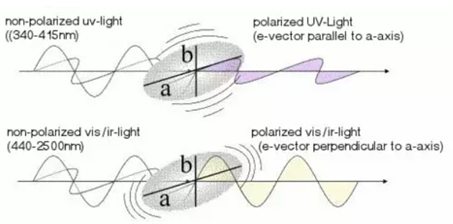Polarization of light
Polarization: Asymmetrical directions of vibration and propagation. Transverse waves can oscillate in different directions because only could the transverse waves polarize. The electric field and the magnetic field of the electromagnetic wave are perpendicular to each other. The polarization direction of the electromagnetic wave refers to the polarization direction of the electric field.
According to polarization, light can be divided into polarized light, completely unpolarized light, and partially polarized light. The vector direction and size of light which change regularly is named as polarized light, including linearly polarized light, elliptically polarized light, and circularly polarized light.
Linear (planar) polarized light: In the direction of light propagation, the light vector only vibrates in a fixed direction. The plane formed by the direction of the light vector and the direction of light propagation is called the vibration plane. The vibration surface of linearly polarized light is fixed and does not rotate.
Elliptically polarized light: the trajectory drawn by the direction of the electric field of the light or the end of the light vector on a plane which is perpendicular to the direction of propagation. When two mutually perpendicular vibrations act on a point at the same time, meanwhile, if their frequencies are the same and there is a fixed phase difference, the trajectory of the resulting vibration at that point is generally elliptical.
Circularly polarized light: The light that traces the circular trajectory of the endpoint of the rotating electrical vector is called circularly polarized light, which is a special case of elliptically polarized light. When the two propagation directions are the same, the vibration directions are perpendicular to each other, and the phase difference is constant at φ = (2m ± 1/2) π, two plane-polarized lights can be superimposed to synthesize circularly polarized light with regular changes in electrical vector.
Polarized optical element
Polarization optical components mainly include polarizers, wave plates, polarizers, polarized beam splitting prisms, birefringent crystals, depolarizers, etc. This article mainly discusses the types, key parameters, and applications of polarizers.
Polarizer: An optical element (or polarizing plate or polarizing film) that turns natural light into polarized light. Applications of polarizers include LCDs, 3D movie glasses, optical isolators, optical attenuators, polarizing stress meters, etc.
Use Malus' Law to quickly distinguish the polarizer: rotate the polarizer against the LCD screen and observe whether the intensity of the transmitted light changes.
Definition of S light / P light
The s light and p light are divided according to the vibration direction of the light vector. The lightwave vector is decomposed into two mutually perpendicular vibration directions. In the direction, the former is called the parallel component (Parallel) and is represented by 'p', the latter is called the vertical component (Senkrecht, German) and is represented by 's'.
Besides, TE waves, TM waves, and TEM waves are defined as follows:
TEM wave: There is no electric field and magnetic field component in the propagation direction, which is called the transverse electromagnetic wave. If the propagation direction of the laser in the resonator is the z-direction, then the electric field and magnetic field of the laser will have no z-direction component! The actual laser mode is a quasi-TEM mode, which allows the existence of Ez and Hz components, but they must be much smaller than the lateral direction component because a larger Ez means that the direction of the wave vector deviates more from the optical axis and easily overflows outside the cavity, so the loss is large and it is difficult to form an oscillation.
TE: transverse electric wave, s-pol: There is a magnetic field component in the direction of propagation but no electric field component, which is called a transverse electric wave. In a planar optical waveguide (closed cavity structure), the electromagnetic field components are Ey, Hx, Hz, and the propagation direction is the z-direction.
TM: transverse magnetic wave, p-pol: There is an electric field component in the propagation direction but no magnetic field component, which is called a transverse magnetic wave. In the planar optical waveguide (closed cavity structure), the electromagnetic field components are Hy, Ex, Ez, and the propagation direction is the z-direction.
The polarization directions of both TE and TM are perpendicular to the incident light. The difference is that the polarization direction of the former is perpendicular to the light plane (composed of incident light and reflected light), and the polarization direction of the latter is parallel to this light plane.

Note: s light / p light, TE wave / TM wave are defined according to the incident surface, and the definition will change when leaving a particular incident surface!
Polarized light generation
Dichroic film polarizer: Anisotropic crystals have different absorption coefficients for polarized light in different vibration directions.

Polarization beam splitter (PBS): When the Brewster angle is incident, the reflected light is s light. When s light is transmitting light, the partially polarized light will polarize with a high degree. The high and low refractive index dielectric films are alternately plated between the right-angle prisms and glued into a cubic prism.

Birefringent crystal: The incident light is decomposed into linearly polarized light whose light vectors are orthogonal to each other, and one of the beams is blocked to obtain linearly polarized light. The picture below shows the Glan-Taylor prism.

Metal wire grid polarizer (Wire Grid Polarizer): reflects s light and transmits p light; high temperature resistance, infrared band application.
Types of polarizers
H polarizer: Invented by Land in 1938, it is widely used at present. The polyvinyl alcohol sheet is heated and stretched in one direction, so that the polymer molecules are arranged in long chains in the stretching direction. Then the sheet is immersed in the iodine solution, and the iodine is attached to the long chain to form an iodine chain. Conductive electrons in iodine molecules can flow along long chains. When a beam of natural light hits the polarizer, due to the high conductivity provided by the iodine molecules, the long-chain molecules arranged in parallel absorb the electric field component in the direction of the parallel long chain. Meanwhile, the electric field component perpendicular to the chain is almost unaffected, which results in the transformation from the transmitted light to linearly polarized light. The direction on the polarizer that can transmit electric vector vibration is called its vibration transmission direction.
J polarizer: The small dichroic quinine sulfate quinine crystals are arranged neatly on a transparent plastic film by electromagnetic or mechanical action.
K polarizer: The manufacturing method of the K polarizer is to place the polyvinyl alcohol film in a high-temperature furnace by using hydrogen chloride as a catalyst to remove some water molecules in the polyvinyl alcohol molecules to form elongated molecules of polymerized ethylene, and then unidirectional stretched. K polarizers have stable photochemical properties and are resistant to moisture and heat, and they are not easily decomposed at high temperatures, but they are relatively expensive.
Silver nanoparticle polarizer: deposit uniformly oriented silver nanoparticles on the glass surface. Due to the surface Plasmon resonance (SPR) effect, the absorption characteristics of silver nanoparticles, which are related to wavelength and polarization, can be controlled by parameters such as width, length, etc. Manufacturers include "Polarcor" polarizing glass of Corning Corporation and “colorPol” of German Cody CODIXX.

The silver nanoparticle polarizer is featured by extremely low loss (30 μm thick, T> 98%) and extremely high extinction ratio in the communication band and can be used for coupling between single-mode optical fibers while maintaining polarization.
References:
[1] https://zh.wikipedia.org/w/index.php?title=%E5%81%8F%E6%8C%AF%E7%89%87&oldid=50759525.
[2] https://zh.wikipedia.org/w/index.php?title=%E5%81%8F%E6%8C%AF&oldid=57015397.
[3] https://www.corning.com/opcomm/oem-solutions/worldwide/en/products/glass-polarizers.html
[4] https://www.codixx.de/en/vis-visible/technology.html